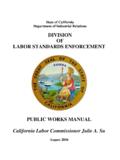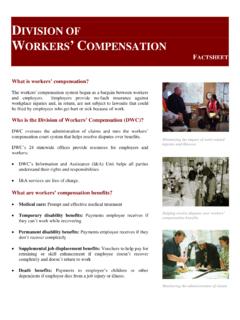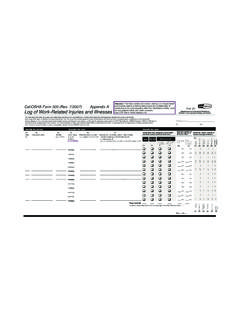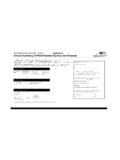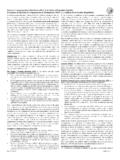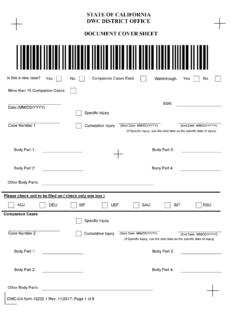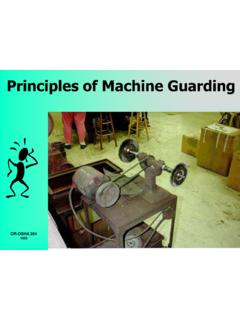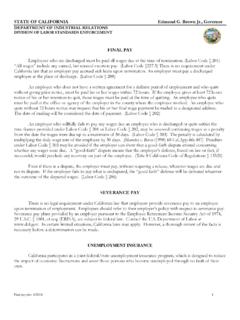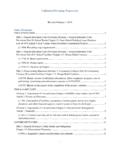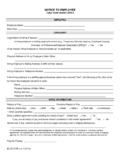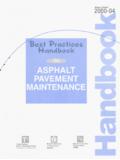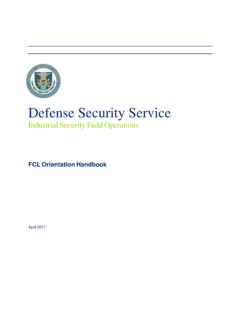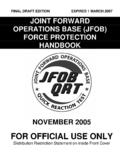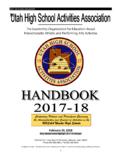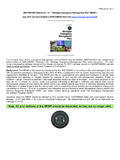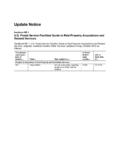Transcription of Helping Injured Employees Return to Work
1 Helping Injured Employees Return to WorkPrepared by the Institute for Research on Labor and Employment, University of California at BerkeleyFor the California Commission on Health and Safety and Workers CompensationFebruary 2010 Practical Guidance Under Workers Compensationand Disability Rights Laws in CaliforniaP A G E 1 Helping Injured Employees Return to WorkPractical Guidance Under Workers Compensation and Disability Rights Laws in CaliforniaPrepared by the Institute for Research on Labor and Employment, University of California at BerkeleyFor the California Commission on Health and Safety and Workers CompensationFebruary 2010P A G E 2 AcknowledgmentsThis handbook was designed and produced by the Institute for Research on Labor and Employment (IRLE), University of California at Berkeley, under a contract with the California Commission on Health and Safety and Workers Compensation (CHSWC).
2 Its goal is to help small employers understand how to comply with both workers compensation and disability rights laws that govern Return to work in California. Project Director Juliann Sum, , Stefanie KalminDesigner Vicki ValentineWe wish to thank California Department of Industrial Relations Director John C. Duncan, 2009 CHSWC Chair Sean McNally, 2010 CHSWC Chair Angie Wei, other members of the Commission, and California Department of Fair Employment and Housing Deputy Director of Employment Jennifer Harlan for their support in this project would not have been possible without the ongoing efforts of CHSWC Executive Officer Christine Baker, Workers Compensation Judge Lachlan Taylor, CHSWC Research Specialist Irina Nemirovsky, CHSWC Program Analyst Selma Meyerowitz, and other CHSWC staff.
3 They guided and collaborated in the project and facilitated participation by the following project advisors and contributors, whom we also wish to acknowledge:Roundtable AttendeesCathy Aguilar, CHSWCSaul Allweiss, Law Office of Saul AllweissLinda Atcherley, Linda Atcherley & AssociatesStuart Baron, Stuart Baron & AssociatesJoe Carrisi, Southern California EdisonRoberta Etcheverry, Diversified Management Group*Scott Hauge, Small Business California and Cal-InsuranceNanette Goldberg Hauser, Southern California EdisonLori Kammerer, Kammerer & Company representing Small Business CaliforniaDoug Kim, Green & Azevedo representing California Applicants Attorneys AssociationRobin Nagel, Kaiser PermanenteCarrie Nevans, California Division of Workers CompensationMichael Nolan, California Workers Compensation InstituteSarah Oliver, Grimmway FarmsPearl Phoenix, Zenith InsuranceSeth Seabury, RAND CorporationMark Webb.
4 Employers Direct Insurance CompanyHerbert Yarbrough, California Department of Fair Employment and HousingAdditional Advisors and ContributorsKathy Biala, Milestone Medical Management AlternativesErika Bruce, State Compensation Insurance FundCalifornia Department of Rehabilitation, Disability Access SectionPatricia Eyres, Stuart Baron & AssociatesJean K. Hyams, Dickson Levy Vinick Burrell Hyams LLPG ideon Letz, , State Compensation Insurance FundHerb Levine, Independent Living Resource Center San FranciscoLeslie F. Levy, Dickson Levy Vinick Burrell Hyams LLPB ryon MacDonald, World Institute on DisabilityPatricia Owens, National Academy of Social Insurance member and former board memberLee Patton, Association of California Water Agencies Joint Powers Insurance AuthorityJoe Severino, State Compensation Insurance Fund*Ms.
5 Etcheverry provided resources and invaluable assistance on an ongoing basis throughout the February 2010, IRLE and CHSWC. All or portions of this handbook may be reproduced without permission for educational purposes. Please credit IRLE and A G E 3 ContentsIntroduction. About This Handbook ..4 Section I. Best Practices in Returning an Injured employee to Work ..6 Step 1. Contact the Injured employee and start the interactive process ..6 Step 2. Describe essential functions and usual duties of jobs ..7 Step 3. Obtain work capacities and restrictions ..7 Step 4. Research and evaluate possible accommodations ..8 Step 5. Select a reasonable accommodation and make an offer of work ..9 Step 6. Implement and monitor the accommodation ..10 Section II. Establishing an Effective Return -to-Work Program.
6 11 Develop and formalize your policies and procedures ..11 Evaluate existing jobs and working conditions ..12 Ensure everyone assumes their roles and responsibilities ..13 AppendicesA. Examples Comparing Essential Functions and Usual Duties of a Job ..16B. Time Frames for Engaging in the Interactive Process and Offering Work ..17C. Examples of Return to Work in Construction and Agriculture ..20D. Additional Resources ..22E. California Workers Compensation Laws ..25F. California Disability Rights Laws ..28P A G E 4 INTRODUCTIONA bout This HandbookWhen a work-related injury prevents an employee from returning to his or her original job and working conditions, the employer must navigate both workers compensation and disability rights laws. These two sets of laws, however, have distinctly different goals, approaches, time frames, and definitions.
7 Navigating the laws can be a complicated process for the typical small business employer, who does not have the benefit of a human resources department to ensure handbook provides guidance for small business employers. It describes how to establish and implement an effective Return -to-work program, coordinate the Return -to-work process with the Injured employee s workers compensation benefits, and ultimately strengthen the work environment and overall health of the company or organization. For Employees of small businesses, the handbook describes the goals and benefits of returning to work, everyone s roles and responsibilities, and what can be expected in the process. Larger employers and their Employees may also find this handbook primary focus of this handbook is the interplay between workers compensation and disability rights laws.
8 To read more about workers compensation benefits and other assistance available to Injured workers, see Workers Compensation in California: A Guidebook for Injured Workers, 3rd Edition, November 2006, and updates to the guidebook. They are available online at (link to Find the most recent Guidebook for Injured Workers ). To access further information about workers compensation requirements, disability rights in employment, and job-protected leave for Employees with serious health conditions, see Appendix D of this A G E 5 The main portion of the handbook is organized as follows:Section I discusses six basic steps that constitute best practices to help an Injured employee Return to safe and appropriate work in a timely fashion. The information is based on recommendations from experts and practitioners in the field and on the actual legal II discusses how to establish an effective program to carry out the best six appendices give examples of essential functions of jobs, discuss time frames for engaging in the interactive process and offering work, describe Return -to-work scenarios in construction and agriculture, list additional resources, and cite the different laws governing Return to handbook encourages collaboration between employers and Injured Employees to find effective ways to accommodate job injuries.
9 Working together will serve as a model for coworkers and colleagues. It will also contribute to health, well-being, and equal opportunity in employment, and to increased productivity in our workforce and A G E 6 SECTION 1 Best Practices in Returning an Injured employee to WorkAn effective Return -to-work program can benefit employers in numerous ways. Such a program can help avoid millions of dollars in fines and penalties, reduce workers compensation costs, retain experienced Employees , improve employee morale and productivity, increase competitiveness of a business, and help ensure equal opportunity of employment for persons with disabilities. Employees participating in Return to work can protect their jobs and income, avoid long-term unemployment, stay physically conditioned and mentally active, maintain daily structure and social connections provided by work, and participate in injury and illness prevention programs in the section describes six basic steps that constitute best practices to help an employee with a work-related injury or illness Return to 1.
10 Contact the Injured employee and start the interactive processWhen an employee has been hurt on the job, personally contact the employee and provide a Workers Compensation Claim Form (DWC 1). Before providing the form, if possible fill in the employer s name and address, employee s name, date employer first knew of injury, and date the claim form is being provided to the employee . Encourage the employee to read the information attached to the form, and show the employee where to fill in his or her portion. After the employee completes his or her portion, finish filling in the employer s portion and provide copies of the form to the employee and to your insurance the employee that medical care will be provided while the claim is pending and that other benefits may also be provided after the claim is accepted.
